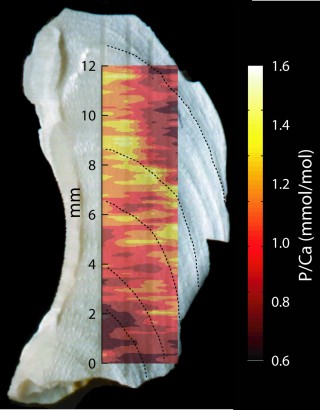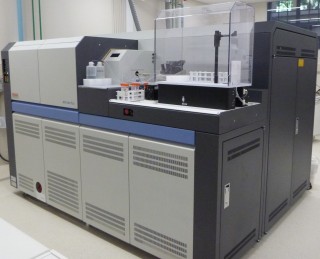
One of the main goals of this expedition was to explore the diversity of deep sea corals in Perth Canyon and to collect a variety of specimens for later geochemical analysis in the laboratory. The skeletons of deep sea corals are of high interest to scientists because their geochemical composition provides a record of how the oceans have changed over the past centuries to millennia due to the longevity and slow growth rates of these corals. This is critical information because instrumental records are largely non-existent, especially for inaccessible areas of the ocean such as the deep sea.
Geochemical proxies in coral skeletons

When coral skeletons form, they record the environmental conditions of the seawater from which the calcium carbonate is precipitated. For example, the skeletal boron isotopic composition records seawater pH, whereas the oxygen isotopic composition records water temperature and salinity. In addition, certain elemental ratios, such as Sr/Ca, Li/Mg, and B/Ca, and specific radiogenic isotopes trace water temperature, carbonate chemistry parameters, and water mass circulation.
This environmental information will be extracted from the coral skeletons using specialised, highly precise mass spectrometers at the University of Western Australia. By comparing the geochemical data to the direct measurements of seawater parameters obtained during the cruise, scientists can accurately calibrate the relationship between environmental signals and geochemical proxy data. Further, it will allow them to reconstruct the distribution of different water masses within the Canyon, such as the upwelling of nutrient-rich, low-pH water, over the past centuries to millennia.
Another important type of information stored in coral skeletons is the age of the coral itself. This can be done using a radiometric dating technique called uranium-thorium dating and will help scientists to determine the age of both fossil and modern corals that we collected from the Perth Canyon. Their estimated time of death can then be related back to major changes in ocean chemistry occurring at the same time, thus enabling us to understand how resistant or vulnerable deep sea corals are to ocean change.
Mineralogy determines vulnerability to ocean change

As already discussed in a previous post, the world’s oceans are rapidly acidifying (a decrease in seawater pH), which threatens many marine calcifying organisms such as corals and molluscs because it makes it harder for them to build their calcium skeletons and shells. However, this is more the case for some types of coral than for others and depends on the form of calcium carbonate that they produce.
For example, the deep sea coral Desmophyllum spp., which is abundant in Perth Canyon, produces a skeleton made of aragonite, whereas bamboo corals form calcitic skeletons. Although aragonite dissolves in seawater more easily than calcite, aragonitic corals have an efficient buffer mechanism that allows them to calcify even in corrosive seawater. This is particularly important for deep sea aragonitic corals because the depth at which seawater becomes corrosive or undersaturated with respect to aragonite is much shallower than that for calcite. However, calcitic corals do not have the same buffer mechanism and are thus more vulnerable to low seawater pH than aragonitic corals.
The deep sea as a natural laboratory
The deep sea is therefore an environment that is ideally suited to study the resistance of coral calcification to significant perturbations in seawater carbonate chemistry, as already experienced by shallow water corals due to ocean acidification. Consequently, deep sea corals not only represent key archives of past ocean change but also allow us to catch a glimpse into the future of coral reefs.


